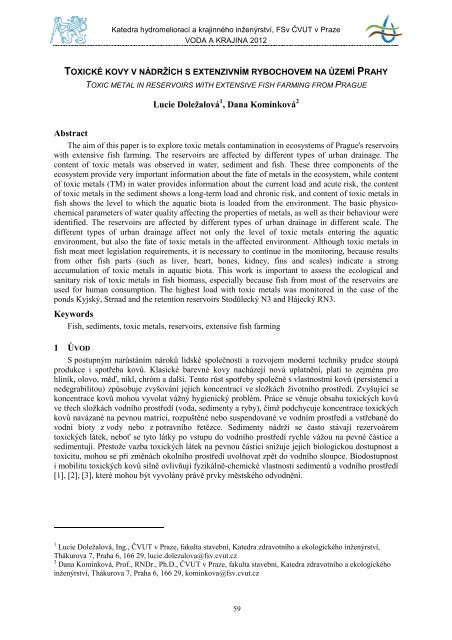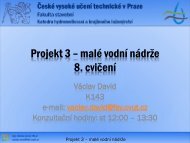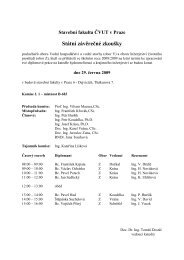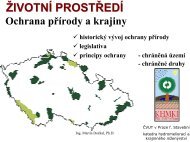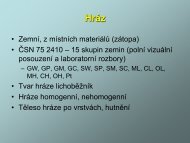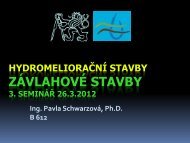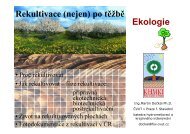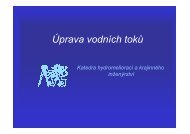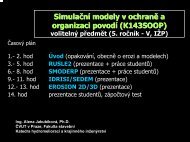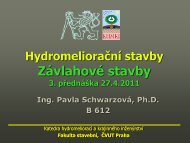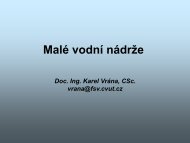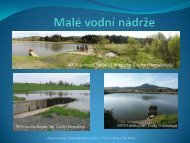SbornÃk pÅÃspÄvků 2012 - Katedra hydromelioracà a krajinného ...
SbornÃk pÅÃspÄvků 2012 - Katedra hydromelioracà a krajinného ...
SbornÃk pÅÃspÄvků 2012 - Katedra hydromelioracà a krajinného ...
- No tags were found...
You also want an ePaper? Increase the reach of your titles
YUMPU automatically turns print PDFs into web optimized ePapers that Google loves.
<strong>Katedra</strong> hydromeliorací a krajinného inženýrství, FSv ČVUT v PrazeVODA A KRAJINA <strong>2012</strong>TOXICKÉ KOVY V NÁDRŽÍCH S EXTENZIVNÍM RYBOCHOVEM NA ÚZEMÍ PRAHYTOXIC METAL IN RESERVOIRS WITH EXTENSIVE FISH FARMING FROM PRAGUELucie Doležalová 1 , Dana Komínková 2AbstractThe aim of this paper is to explore toxic metals contamination in ecosystems of Prague's reservoirswith extensive fish farming. The reservoirs are affected by different types of urban drainage. Thecontent of toxic metals was observed in water, sediment and fish. These three components of theecosystem provide very important information about the fate of metals in the ecosystem, while contentof toxic metals (TM) in water provides information about the current load and acute risk, the contentof toxic metals in the sediment shows a long-term load and chronic risk, and content of toxic metals infish shows the level to which the aquatic biota is loaded from the environment. The basic physicochemicalparameters of water quality affecting the properties of metals, as well as their behaviour wereidentified. The reservoirs are affected by different types of urban drainage in different scale. Thedifferent types of urban drainage affect not only the level of toxic metals entering the aquaticenvironment, but also the fate of toxic metals in the affected environment. Although toxic metals infish meat meet legislation requirements, it is necessary to continue in the monitoring, because resultsfrom other fish parts (such as liver, heart, bones, kidney, fins and scales) indicate a strongaccumulation of toxic metals in aquatic biota. This work is important to assess the ecological andsanitary risk of toxic metals in fish biomass, especially because fish from most of the reservoirs areused for human consumption. The highest load with toxic metals was monitored in the case of theponds Kyjský, Strnad and the retention reservoirs Stodůlecký N3 and Hájecký RN3.KeywordsFish, sediments, toxic metals, reservoirs, extensive fish farming1 ÚVODS postupným narůstáním nároků lidské společnosti a rozvojem moderní techniky prudce stoupáprodukce i spotřeba kovů. Klasické barevné kovy nacházejí nová uplatnění, platí to zejména prohliník, olovo, měď, nikl, chróm a další. Tento růst spotřeby společně s vlastnostmi kovů (persistencí anedegrabilitou) způsobuje zvyšování jejich koncentrací ve složkách životního prostředí. Zvyšující sekoncentrace kovů mohou vyvolat vážný hygienický problém. Práce se věnuje obsahu toxických kovůve třech složkách vodního prostředí (voda, sedimenty a ryby), čímž podchycuje koncentrace toxickýchkovů navázané na pevnou matrici, rozpuštěné nebo suspendované ve vodním prostředí a vstřebané dovodní bioty z vody nebo z potravního řetězce. Sedimenty nádrží se často stávají rezervoáremtoxických látek, neboť se tyto látky po vstupu do vodního prostředí rychle vážou na pevné částice asedimentují. Přestože vazba toxických látek na pevnou částici snižuje jejich biologickou dostupnost atoxicitu, mohou se při změnách okolního prostředí uvolňovat zpět do vodního sloupce. Biodostupnosti mobilitu toxických kovů silně ovlivňují fyzikálně-chemické vlastnosti sedimentů a vodního prostředí[1], [2], [3], které mohou být vyvolány právě prvky městského odvodnění.1 Lucie Doležalová, Ing., ČVUT v Praze, fakulta stavební, <strong>Katedra</strong> zdravotního a ekologického inženýrství,Thákurova 7, Praha 6, 166 29, lucie.dolezalova@fsv.cvut.cz2 Dana Komínková, Prof., RNDr., Ph.D., ČVUT v Praze, fakulta stavební, <strong>Katedra</strong> zdravotního a ekologickéhoinženýrství, Thákurova 7, Praha 6, 166 29, kominkova@fsv.cvut.cz59


